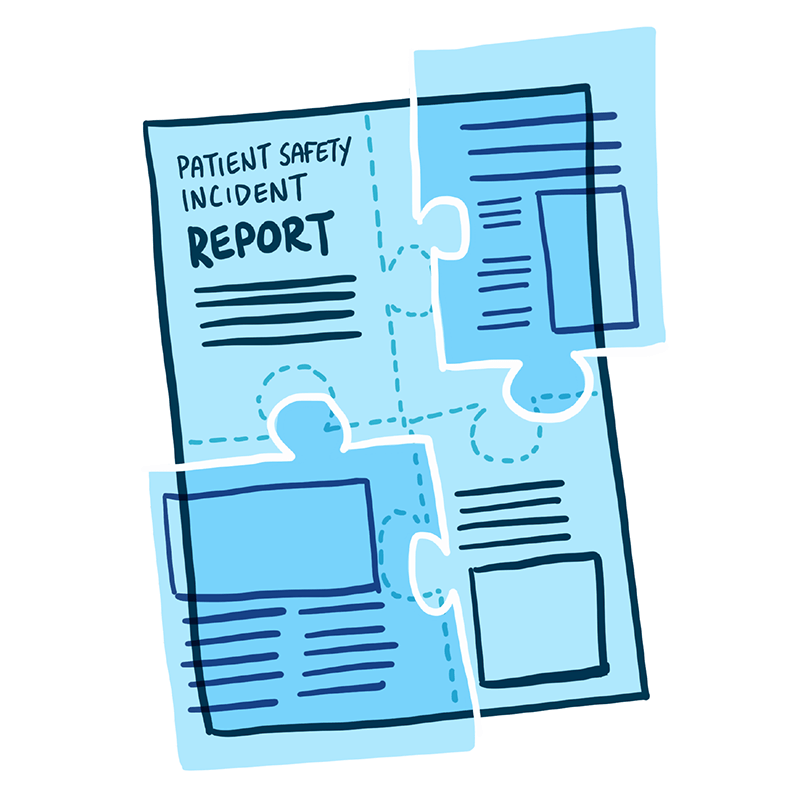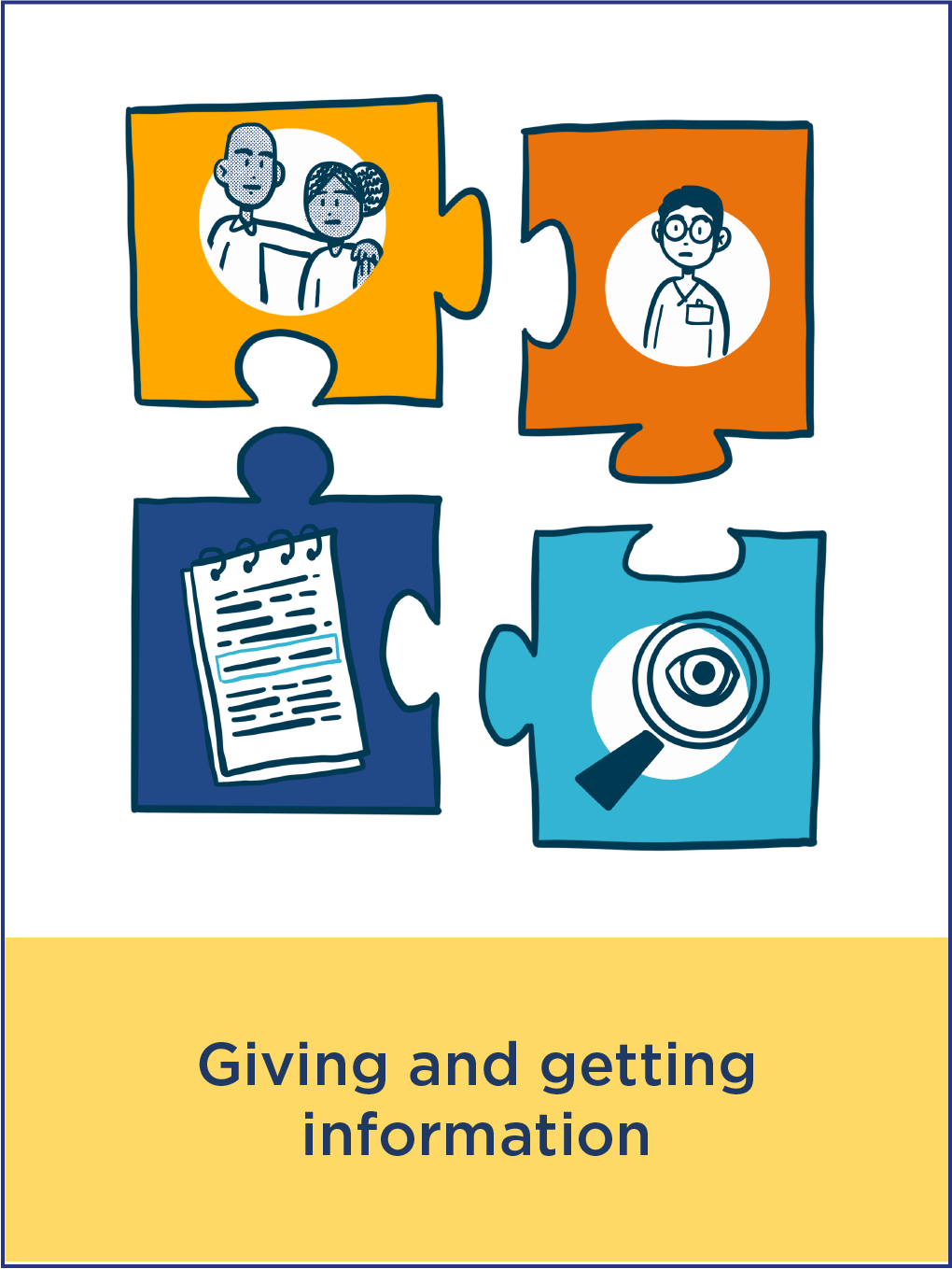Support for Patients and Families
If you have found yourself here, you have likely been involved in an incident that is now being investigated. Everyone is different, but we understand that this may be a very difficult time for you.
The resources on this website have been designed, together with people who have experienced patient safety incidents and investigations, to provide you with the information and support you might need. Hopefully, this will make the process as easy and as meaningful for you as possible.

How will I be involved?
Why be involved?
Joanne Hughes –
I became interested in patient safety back in 2011 when I lost my daughter, Jasmine. So, Jasmine was 20 months old. She had what we thought was a nasty cold or flu. and then after that, she just didn’t seem to get back to being herself.
She’d developed a post-viral form of encephalitis, which is inflammation in the brain. During that three week period, where a diagnosis was being made about what was going on neurologically, she’d also had 28 readings of her blood pressure, and that had been plotted on what’s called Pews chart. And it had been plotted and seen it was stable, but there was a separate sheet that needed to be checked to understand if the blood pressure that she had was within normal range for her age and that had been missed.
So she had actually had consistent quite severe hypertension as well, which is something that can happen if you’ve got an inflammatory process going on in your brain. The steroid, the drug that she needed to treat her inflammatory illness and dampen down her immune system so that she could recover, is actually a ‘Use with caution’ drug in patients with hypertension. The staff giving it to her and also myself were not aware of this risk.
When the sets of OBS were done on her, they missed out the blood pressure reading when they first, before giving her the drug and she developed a drop on one side of her face and then she started to seize. She had to be transferred to intensive care then and further assumptions were made there. This previous history of at least three weeks of hypertension was missed and as a result, the target blood pressure that she was given when she first went to intensive care was too low and her blood pressure was allowed to fall too low too quickly. She had inadequate oxygen to her brain and her brain stem was irreversibly damaged.
Devastating and heartbreaking for me and always will be to remember the suffering that she endured and I couldn’t help her.
I needed that sense of security, that there were people within the Trusts and the staff that had been involved in the incident, who had the skills and the knowledge and the expertise to painstakingly and accurately piece together what had happened. To feel trust and confidence that they wanted to do that and that they would involve me.
So, I think patients and families really should get involved in investigations, you know, if they can and get the support they need, if they need support to be involved. Because, this is actually their experience, this is their life that’s being investigated and it is very stressful and upsetting if a report presents a version of your experience, your significant, often life experience, something that’s impacted you, it is a huge part of you and who you are, is represented in ways that other people have put together that doesn’t fully chime with what your experience has been? So it’s very important, I think, to make sure that your voice is heard and your perspective is heard to avoid that happening, because that can be very painful.
So, I think the booklet for patients and families are going to be so helpful because they, one include vignettes and snippets of information from real people who have been there before to help them feel less isolated and understand that this has been put together by peers, people like them, people who really get it. It’s information about the process and what the process means to them and how it can help them with their journey as they try to process and move forward from the event.
So what’s in it for them for being engaged as well as what they can give to the process. And I think it’s empowering because it sets out what good looks like and what they can ask for. The questions and the prompts within the document will help people to be thinking along the lines of how we as people who have been through it and who have a good understanding of how things all work, would want people to be thinking early on. You know, the prompts have been developed with us as peers influencing those.
And of course, by having that document, they can also hold investigators of the organisation that are doing the investigation to account on delivering on the standards that are set out and the principles for how they should be engaged and involved with, that run throughout all of the documents as well. So that it is experienced as helpful and as compassionate and as meaningful engagement that really respects their voice.
But, what I would say is if there’s an opportunity for patients and families to look at the timeline of events that’s been put together, the chronology of events very early on, and provide any comment or extra information or highlight things that they don’t remember it being quite that way, soon in the process so that the whole process doesn’t run away with a narrative or a chronology that is something that actually doesn’t fit with what they remember. And I think that these materials will help people start to achieve that.
Our experience of an investigation
SAM
My name is Sam.
JULIA
My name is Julia. And this is Celeste. Yeah, this is Celeste
SAM
Julia’s pregnancy was just kind of completely normal. We didn’t really have any issues. There weren’t any major risk factors. Just like a few really very small ones. Everything kind of went ahead normally, all the scans were normal, but she kind of had, when she was born, she wasn’t breathing. They obviously had to kind of take her to the baby intensive, intensive care unit. And she spent kind of her first two weeks in there with us, kind of staying on the ward and kind of trying to be visiting her as much as possible during that time. And she had to be kind of therapeutically cooled as well when she was born, because she was born kind of not breathing and they were worried about her brain and so it was a quite involved process. It was quite a big shock to us, I think.
JULIA
Yeah, I think the longer we stayed there, after kind of as well, the adrenaline of actually giving birth had worn off. I think it kind of became a bit more obvious that there might well be long term kind of implications of how she had been born. And the more we saw her in the hospital and the more tests they were doing, and then they did the MRI scan of her brain. I kind of came to terms with the fact that, like actually, there might just be things that we live with now that are not what we expected and not what we’d really prepared for.
So, once we’d been in the hospital for about a week or so, a senior midwife came and spoke to us and said that because she had the therapeutic cooling after she was born, she had to be investigated. So, all of her notes and all of the kind of observations, everything about her labour and her birth would be reviewed by the hospital, but it would also be reviewed by this independent body. HSIB.
ANDY
So I’m Andy Yelland. I’m a maternity investigator for HSIB.
Probably the first thing we do is to call the parents, initially, to say that we’re going to do the investigation. Then we set up a meeting, with the family and we do it with the family in mind because we want to make sure that it’s in a place that they feel comfortable talking about things.
SAM
We knew it’d be quite a long process and we knew it might be quite difficult, but we kind of wanted to meet them in person so that we could kind of talk to them and get to know them and make sure that kind of we were happy with what they had taken away from that conversation. And we basically just went through everything that had happened during the pregnancy, during the labour, during the birth and all from our perspective. And they listened and I think they were very aware of like the fact that it was quite a tricky thing for us that we’d gone through and they wanted to make sure we felt comfortable and kind of we felt like they were getting a true picture from our perspective of what actually happened, and it didn’t feel like it was just going to be a witch hunt, which was something else we were worried about.
ANDY
We don’t interview staff because we think they’ve done something wrong. We interview staff that are on the timeline, really that have a narrative of events which, like the family, have a narrative of what happened to them. Staff also have a narrative of events.
SAM
For us, there was a few reasons why we wanted to be involved. Probably the main one was just that we didn’t really have a clear idea, at that time, of what had caused Celeste’s difficult birth and she was in such a bad way and we just didn’t want anyone else to go through what we went through.
JULIA
It was really important to us to really understand everything that happened, even though we can’t change anything about it, at least we can understand it and come to terms with it a bit better.
SAM
It also gave us the chance to give our perspective about those events because, you know, when we got to a stage where we had seen the draft report, you know, there were some things that we disagreed with or we recall differently or whatever and part of the process that they made very clear to us is, you know, you have a say in what goes into this report. So, there were things that we said and it did change how the report was written. I think for us that was that was helpful as well because it just felt like a truer event of, a truer account of what we had actually experienced.
JULIA
When something like that happens that you’re not prepared for. I’m sure Sam felt the same, but I personally felt as though I had no control over what was happening at all and us interacting with the report and actually saying, No, actually I think this is what happened or that’s not how I remember it. Or actually, I don’t think that’s a fair representation, just gave us a little bit more kind of agency back in terms of, you know, feeling like we did have some control over how that was described and how it was portrayed and shared with people, which we hadn’t really had since she was born.
ANDY
I think we have to be compassionate because we’re dealing with ultimately very sensitive issues. Death, death and injury, really, and bereavement.
SAM
There’s certain things that we still have to like do with Celeste, like she has like physiotherapy and stuff. And, you know, I think like for us, obviously the hope is that she will just get to a stage where she doesn’t need that anymore and that intervention has served its purpose.
JULIA
It’s not like that just happened and nobody tried to prevent it from happening, happening again for anyone else, but also just for us personally. If we want to stay here and do the same thing, then we can feel a bit more confident that hopefully it will be better.

Stage 1: Understanding you and your needs
You will be introduced to your main point of contact. They will meet with you and give you time and space to share what you know about what happened and what you might need. There is space within the Patient and Family Guide to think through what you might like to discuss. Patients and families who have experienced a patient safety incident say that getting involved in this stage might be an important step on the road to recovery and making sense of what happened.

Stage 2: Agreeing how we work together
It is unlikely that you have been involved in something like this before. The information in the Patient and Family Guide will help you know what to expect from the process. Your main point of contact will be happy to answer any of your questions and will work with you according to your preferences. Together, you will agree what the investigation will look at.

Stage 3: Giving and getting information
The investigation is a bit like a jigsaw. There are different pieces of information relating to the patient safety incident. The investigation gathers the different information and tries to understand different people’s experiences of what happened, as well as pulling together common themes and finding points of disagreement. You are a key part of this jigsaw. You have a unique and valuable perspective on what happened and may have information others do not have access to.

Stage 4: Checking and finalising the report
All of the information gathered from different perspectives will be brought together to produce a report. This outlines what was thought to have happened and how. It may also outline key learning points aiming to reduce the likelihood of it happening again, and what actions might need to be taken by the NHS Trust based on these points. Your guide will help you to get prepared for receiving the report, and provides space for you to note down your reflections and any feedback you want to provide to your main point of contact. You will be supported and guided through the process.

Stage 5: Next steps
Your main point of contact will provide you with a copy of the final report. You might want to meet with them to discuss what has changed as a result of your feedback, as well as your thoughts and reflections. As the formal process comes to an end, hopefully, you will be able to move forwards feeling reassured by the investigation outcome. However, you may still need further support. Please look at the information in the Patient and Family Guide and speak to your main point of contact to find out more about how to access the appropriate support.














